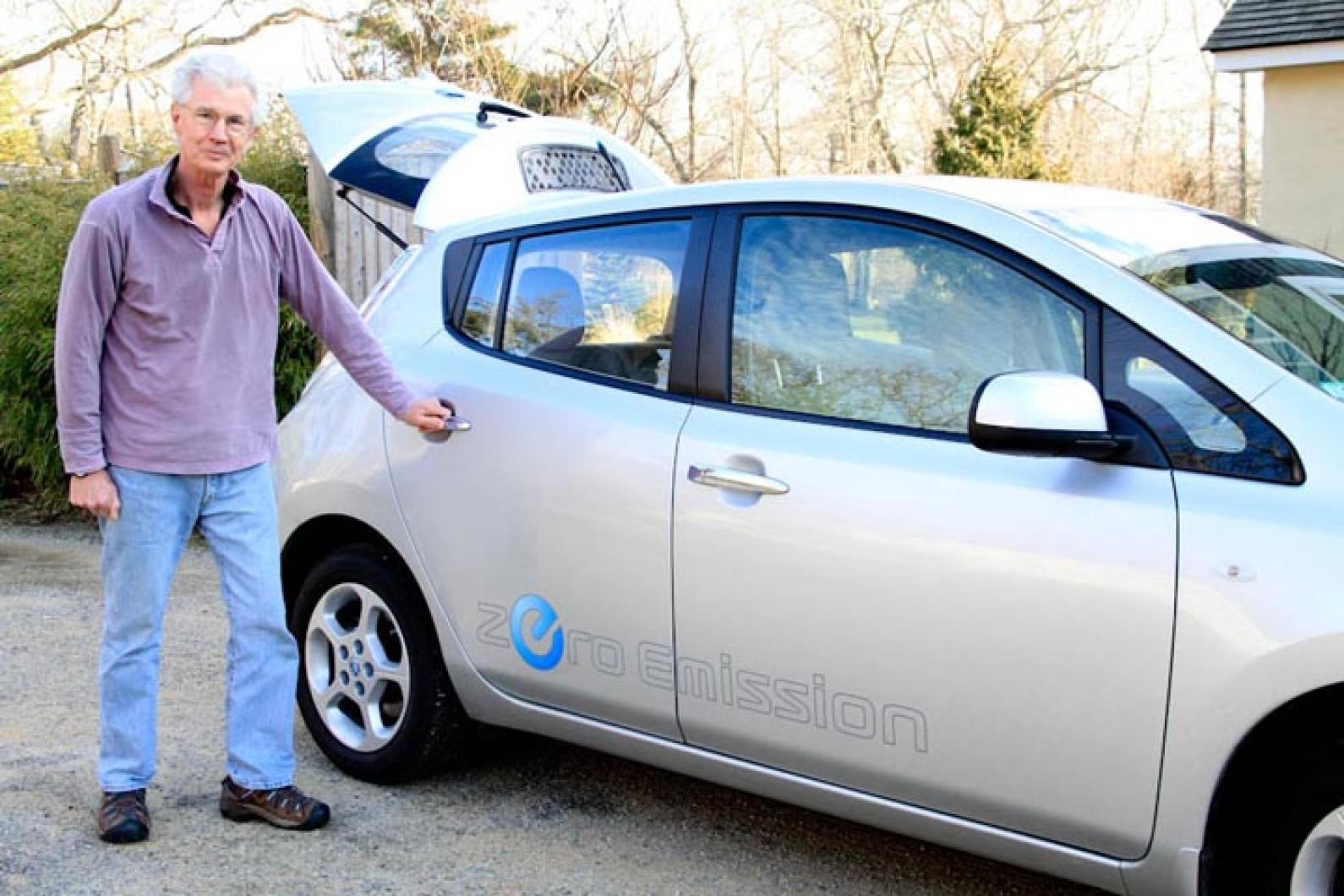Ted Bayne approached one of the signature hilly turns on Lambert’s Cove Road and hit the — well, not the gas.
“If you turn off eco-mode, this thing screams,” he said.
Pulling G forces in an all-electric car, you are quickly disabused of the notion that going green means sacrificing performance.
But while Mr. Bayne’s new Nissan Leaf (what may be the only all-electric car on the Island) can still go from zero to 60 in seven seconds and top 90 miles an hour, carmakers like Nissan are trying to change the way gas-guzzling Americans drive.
When he drives in eco-mode, Mr. Bayne’s car employs what is known as regenerative braking, slowing the car’s forward motion and converting that resistance into more electricity, much like an alternator. All the while, Mr. Bayne is coached by a display of trees on his dashboard that slowly light up the more economically he drives.
“It’s so hokey,” he laughed.
When he drops below 19 miles an hour the otherwise nearly silent car pumps out artificial noise to alert pedestrians of its engine-less presence.
If the Martha’s Vineyard Commission is to be believed, this is the next big thing on the Vineyard. The commission’s 2009 Island Plan envisions emission-free Vineyard roadways.
“In the long term, replacing the use of combustion engines with other available technologies such as electric motors... in combination with locally generated energy from renewable sources will allow us to work toward the goal of zero emissions for the Island’s transportation sector,” the plan says in part.
Mr. Bayne is a board member for Vineyard Power, the Island’s fledgling energy cooperative that among other things is committed to help make that vision a reality. Last week the energy cooperative unveiled plans at the MVC for six electric car charging stations attached to a canopy of solar panels over the Cronig’s Market parking lot in Vineyard Haven.
Mr. Bayne’s charging station is his house. Running from a small panel next to his driveway, a cord with a nozzle at the end is lodged in the car’s front end. From the comfort of his laptop, Mr. Bayne can see how much juice his car needs (a full recharge typically takes six to seven hours while more expensive so-called quick chargers can power a car in half an hour). But there are other, more interesting statistics available on his computer. While he is driving, Mr. Bayne’s car uses 3G mobile to communicate with the Nissan cloud about his driving performance. Afterward, he is able to compare his energy usage to other Leaf owners. Like an arcade game, the rankings on the leaderboard are intended to bring out the driver’s competitive spirit.
“I’m at 3.4 metres per kilowatt hour which is pathetic,” he said.
Atop the leaderboard on Wednesday a veritable Captain Planet taunted Mr. Bayne with a driving performance of 17 metres per kilowatt hour. Still, the greenness of any electric car is dependent on its energy source.
“CO2 emissions are a difficult thing because if you compare a gas car going 100 miles versus an electric car going 100 miles you’re still generating CO2 emissions because of the generating plant,” he said. “Still, it ends up very favorable toward the electric car.”
In other words, being truly green means plugging into energy from sources other than coal and fossil fuel-based utilities.
But the car also has its economic benefits. After a $7,500 federal tax credit the 2012 Leaf’s base price is $27,700, but without the need for gasoline as fuel, naturally the savings continue long after.
“It costs me $4.75 to charge the battery completely and I get 100 miles,” Mr. Bayne said. “If I drove 100 miles in my Camry and filled up the tank it would take four gallons at $4.25 a gallon. So that’s 18 bucks.”
To improve those economics, Mr. Bayne is continually modifying his behavior to maximize his car’s range. The mild winter has been a boon to Mr. Bayne’s energy usage; heating drops the car’s range to 85 miles. To avoid losing range, Mr. Bayne has been heating the car while its plugged in before he drives and uses only the heated steering wheel and heated seats that are powered by a separate 12-volt battery that is powered by a solar panel on the car’s roof. He said when it gets truly cold he and his wife may being a blanket in the car rather than turn on the energy-sapping climate control system.
But as battery standards continue to improve Mr. Bayne said the phenomenon of so-called range anxiety, familiar to some mainland electric car owners, has less relevance on the Island.
“I could drive to Aquinnah and back five times,” he said gleefully. “The Island is perfect for this.”





Comments
Comment policy »